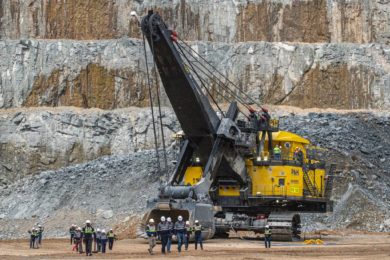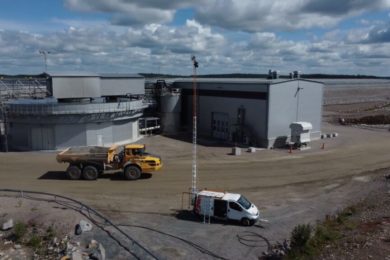 Rio Tinto helding an investor seminar in Sydney yesterday that included an in-depth look at its Iron Ore and Diamonds & Minerals product groups. Chief Executive Tom Albanese said “Rio Tinto is very well positioned despite the challenging global economic environment. Today we are highlighting the strong future earnings potential from iron ore volume increases and higher-priced new titanium dioxide contracts. And we are showcasing the excellence of our West Australian iron ore business, which is delivering productivity improvements and holding down the costs of expansion despite the current headwinds.“We are taking further tough action to roll back the unsustainable cost increases of the past few years and are maintaining a relentless focus on improving productivity. We are investing in the highest returning opportunities, delivering major projects on time and are taking advantage of the inbuilt flexibility in our phased investment programmes. We have the ability to respond to changing market conditions and I am confident we have the right strategy to maximise shareholder value in the long term.”
Rio Tinto helding an investor seminar in Sydney yesterday that included an in-depth look at its Iron Ore and Diamonds & Minerals product groups. Chief Executive Tom Albanese said “Rio Tinto is very well positioned despite the challenging global economic environment. Today we are highlighting the strong future earnings potential from iron ore volume increases and higher-priced new titanium dioxide contracts. And we are showcasing the excellence of our West Australian iron ore business, which is delivering productivity improvements and holding down the costs of expansion despite the current headwinds.“We are taking further tough action to roll back the unsustainable cost increases of the past few years and are maintaining a relentless focus on improving productivity. We are investing in the highest returning opportunities, delivering major projects on time and are taking advantage of the inbuilt flexibility in our phased investment programmes. We have the ability to respond to changing market conditions and I am confident we have the right strategy to maximise shareholder value in the long term.”
Rio believes the short-term macroeconomic outlook remains volatile, with major uncertainties around future US and European economic growth. However, it is guardedly optimistic on China’s prospects. A number of recent macro leading indicators have beaten market expectations, suggesting early signs of economic pickup. Rio expects this to continue in 2013, leading to a slight rise in Chinese GDP growth to above 8% next year.
Rio’s strategy of investing in and operating large, long-term, cost-competitive mines and assets is unchanged. It is committed to a strong balance sheet and aims to maintain a single A credit rating.
The company says its strong track record in productivity improvement and management of major capital projects continues to deliver increased value:
- Current nameplate capacity in the Pilbara has risen from 230 (Mt/y to 237 Mt/y through de-bottlenecking and productivity improvement, with minimal capital spend; this increases the capacity of the expansion programme from 353 to 360 Mt/y
- The capital intensity of the Pilbara expansion programme from 220 to 360 Mt/y remains at the mid-$150s per tonne level despite a strong Australian dollar; this has been made possible through capital efficiency and productivity improvements including a S$1 billion saving from reconfiguring the mine plan.
Rio Tinto is continuing its drive for further cost reductions:
- It is targeting cumulative savings of more than $5 billion of operating and support costs by the end of 2014 compared with expected costs in 2012, based on current market conditions and stable operating conditions
- Planned spending on exploration and evaluation projects will be reduced by $1 billion over the remainder of 2012 and 2013
- Capital expenditure on approved and sustaining projects will taper off from current levels in 2013
- Sustaining capital expenditure will reduce by more than US$1 billion next year.
Rio Tinto will benefit from three major sources of production growth in 2013:
- Expansion of 53 Mt/y of iron ore production capacity as the Pilbara operations reach capacity of 290 Mt/y in the fourth quarter
- First commercial production from the Oyu Tolgoi copper-gold mine in the first half, following the successful conclusion of a power supply agreement earlier this month
- The ongoing ramp up of the Yarwun 2 alumina refinery, which started production in the second half of 2012, and is already producing at around 90% of nameplate capacity.
As China and other emerging economies become more consumption-led, Rio Tinto is set to benefit from mid- to late-cycle commodities such as titanium dioxide. The business will become a more significant contributor to Rio Tinto earnings from 2013 as long-term contracts expire, increasing exposure to current market prices, which are up to 300% higher than existing contract averages.
The longer term picture remains positive, with increasing urbanisation in emerging markets driving strong demand growth across a range of commodities, and a slower supply response from the industry.
Other key topics covered at the seminar included those below.
In iron ore, Rio expects Chinese steel demand growth to peak at around 1,000 Mt towards 2030. Rio Tinto Iron Ore (RTIO) continues to be the Pilbara’s lowest cost, most productive operator. The cash cost of production in the Pilbara was $24.50/t in the first half of 2012; the cost per tonne to deliver to China is $47/t, including royalties, shipping and sustaining capital costs; this is expected to reduce when infrastructure expansions are in place. Expansion of capacity in the Pilbara to 290 Mt/y is on track for the fourth quarter of 2013 and on budget. RTIO is reaping competitive advantage from innovation in technology and automation through Rio Tinto’s Mine of the FutureTM program.
Investment in Simandou, the largest undeveloped iron ore deposit in the world, will be phased as the Government of Guinea progresses its financing strategy and grants approvals for the next steps in developing rail and port infrastructure. First shipment of ore is scheduled by mid-2015. The partnership with the Government of Guinea, the Chinalco consortium and the International Finance Corp underpins the development strategy and risk management approach of the project.
Global underlying macro-trends are driving mid-late cycle demand growth for minerals. Rio Tinto is the largest producer of high grade titanium dioxide feedstocks with global feedstock capacity of around 2.2 Mt/y. The doubling of Rio Tinto’s stake in the Richards Bay Minerals TiO2 business is value-accretive and is expected to have a positive cash pay back within five years. Co-products, including zircon, rutile, iron and steel, are recovered to generate substantial additional value. A leading resource and technology position provides options to further expand mining and refining capacity by up to 50%, subject to market conditions.
Rio Tinto has a strong underlying position in borates, with significant options to grow through projects like the development of the kernite processing plant at Boron in California. Options are being created to expand into complementary sectors. The Jadar lithium-borate project in Serbia has the potential to supply 20% of the lithium market. The potash development joint venture in Canada is targeting a tier one resource suitable for solution mining with promising initial results.
In Diamonds, the Argyle underground development is progressing and the first crusher will be commissioned in the first quarter of 2013.









